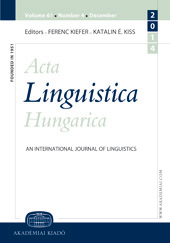Marchand’s analysis of back-formation revisited: Back-formation as a type of conversion
Marchand’s analysis of back-formation revisited: Back-formation as a type of conversion
Author(s): Akiko NaganoSubject(s): Morphology, Syntax
Published by: Akadémiai Kiadó
Keywords: affix deletion; back-formation; clipping; constructional iconicity; zero-derivation/conversion;
Summary/Abstract: Marchand (1960; 1969) presents a unique analysis of back-formation (e.g., editor N > edit V ) as a combination of zero-derivation ( editor N > editor V ) and clipping ( editor V > edit V ). This paper will take a closer look at his analysis and argue that its revised version, which uses the notion of conversion rather than zero-derivation, is superior to the mainstream analyses of back-formation. Citing a lot of instances of back-formed verbs, we will show that back-formation does not necessarily delete an affix (e.g., liaison N > liaise V ), and that it is semantically parallel not to affixation (e.g., film N > filmize V ) but to conversion (e.g., referee N > referee V ). Almost all the preceding analyses fail to deal with these facts, for they are based on the assumption that back-formation deletes a (supposed) affix, or it is the reverse of affixation. Our new analysis, on the other hand, is free from this traditional assumption and can account for various properties of back-formation, including the above two, in terms of general characteristics of conversion and clipping.
Journal: Acta Linguistica Hungarica (Since 2017 Acta Linguistica Academica)
- Issue Year: 54/2007
- Issue No: 1
- Page Range: 33-72
- Page Count: 40
- Language: English

